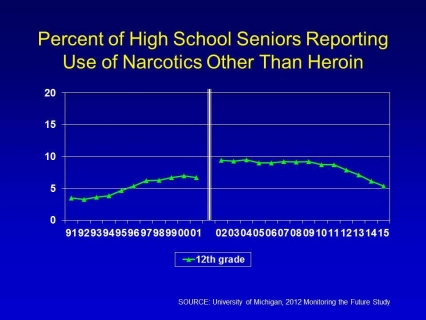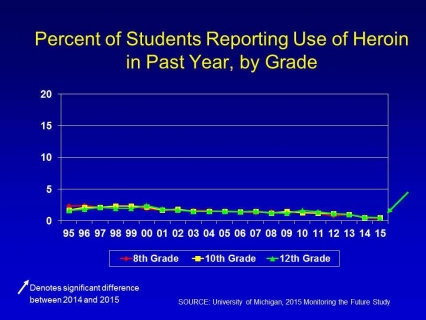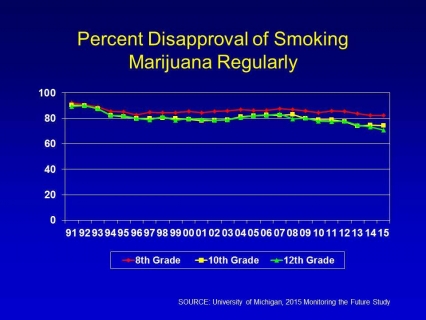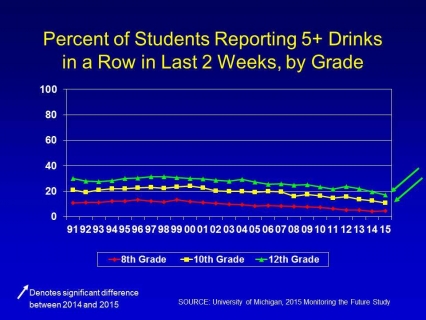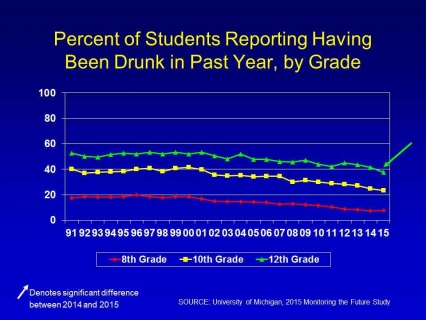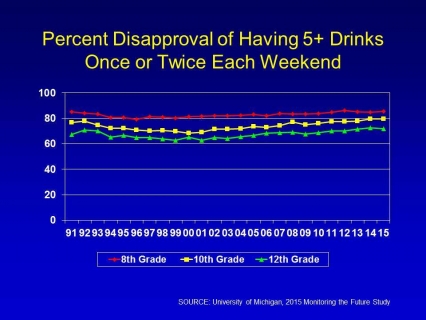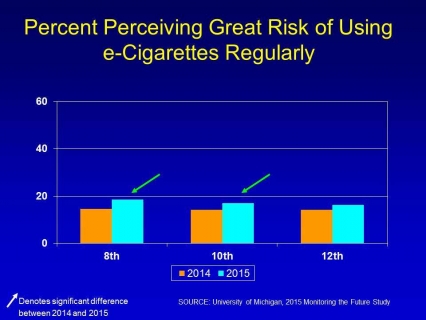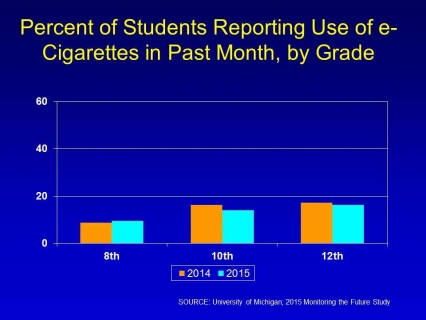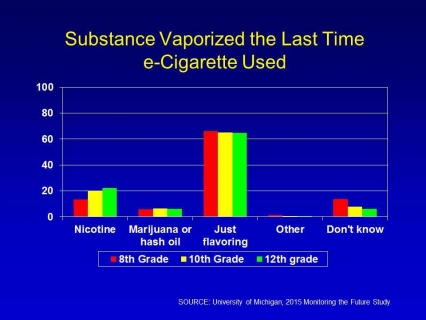This year’s Monitoring the Future (MTF) survey of drug use and attitudes among American 8th, 10th, and 12th graders continues to show encouraging news, with decreasing use of alcohol, cigarettes, and many illicit drugs over the last 5 years—many to their lowest levels since this survey’s inception; no increase in use of marijuana among teens; decreasing use of synthetic drugs; and decreasing misuse of prescription drugs. However, the survey highlighted continuing concerns over the high rate of electronic cigarette (e-cigarette) use and softening of attitudes around some types of drug use, particularly a continued decrease in perceived harm of marijuana use.
The Good News
- Despite the ongoing opioid overdose epidemic, past-year prescription opioid misuse (reported in the survey as ‘narcotics other than heroin’) continued to decline and heroin use is at the lowest rate since the MTF survey began. View Graphs
- For many substances, past-year use has declined to the lowest levels since MTF survey began. View Table
- Marijuana use remained steady among 8th, 10th, and 12th graders over the past 5 years despite softening of perceived risks. View Graphs
- There has been a significant decline in past-year use of synthetic cannabinoids (K2/herbal incense, sometimes called “synthetic marijuana”) since the survey has been tracking its use. View Graph
- Five-year trends continue to show significant decreases in alcohol use among all grades. View Graphs
- Cigarette smoking continues to drop and is currently at its lowest rate in the survey’s history. View Graph
- There was an increase in the percent of 8th and 10th graders who view regular e-cigarette use as harmful. View Graph
Areas of Concern
- The use of e-cigarettes remains high among teens. View Graphs
- Past-month marijuana use continues to exceed cigarette use among high school seniors and, for the first time, daily cigarette use was lower than daily marijuana use. View Graph
The Numbers
The Good News
- Despite the ongoing opioid overdose epidemic, past-year prescription opioid misuse (reported in the survey as ‘narcotics other than heroin’) continued to decline reflecting a significant decrease over the past 5 years. In addition, heroin use is at the lowest rate since the MTF survey began in all ages surveyed. There was a continued steady decline in the perception of availability of heroin among all ages surveyed despite increasing use among adults. There is a continued high rate of disapproval of taking heroin occasionally—95.3 percent among 12th graders.
- For many substances, past-year use has declined to the lowest levels since MTF survey began. This includes heroin, synthetic cannabinoids, Vicodin, methamphetamine, amphetamines, inhalants, ecstasy, alcohol, and cigarettes, among all ages surveyed; hallucinogens, Ritalin, OxyContin, bath salts, and over-the-counter cough medicines among 8th and 10th graders; cocaine among 8th and 12th graders; and prescription pain relievers (narcotics other than heroin), sedatives and crystal meth in 12th graders (the only grade sampled for these substances). Past-year use of illicit drugs was reported by 23.6 percent of 12th graders.
Prevalence of Past-year Drug Use Among 12th Graders Drug Prevalence Alcohol 58.2 Marijuana/Hashish 34.9 Hookah 19.8 Small cigars 15.9 Amphetamines* 7.7 Adderall* 7.5 Snus 5.8 Narcotics o/t Heroin* 5.4 Synthetic Cannabinoids 5.2 Tranquilizers* 4.7 Cough Medicine* 4.6 Vicodin* 4.4 Hallucinogens 4.2 OxyContin* 3.7 Sedatives* 3.6 MDMA (Ecstasy) 3.6 LSD 2.9 Hall other than LSD 2.9 Cocaine (any form) 2.5 Ritalin* 2.0 Inhalants 1.9 Salvia 1.9 * Nonmedical use Categories not mutually exclusive - Marijuana use remained steady among 8th, 10th, and 12th graders over the past 5 years despite softening of perceived risks. Past-month use of smoked marijuana remained steady among 8th graders at 6.5 percent, 10th graders at 14.8 percent, and 12th graders at 21.3 percent. Six percent of 12th graders report daily use of marijuana. The majority of high school seniors do not think occasional marijuana smoking is harmful, with only 31.9 percent saying that regular use puts the user at great risk compared to 78.6 percent in 1991. However, disapproval of regularly smoking marijuana remains relatively high at 70.7 percent among 12th graders, although this rate has gradually declined from a high of 90.1 percent in 1992.
- There has been a significant decline in past-year use of synthetic cannabinoids (K2/herbal incense, sometimes called “synthetic marijuana”) since the survey has been tracking its use. Only 5.2 percent of 12th graders reported its use this year, compared to 11.3 percent in 2012. This is associated with an increase, over the same period, in the perceived risk of taking synthetic marijuana once or twice among 12th graders.
- Five-year trends continue to show significant decreases in alcohol use among all grades. Past-month use of alcohol was 9.7 percent, 21.5 percent, and 35.3 percent of 8th, 10th and 12th graders, respectively, compared to 5 years ago, with rates at 13.8 percent, 28.9 percent, and 41.2 percent in 2010. There was also a significant drop in daily use of alcohol among 10th graders, in 12th grade students reporting being drunk in the past year, and in binge drinking among 10th and 12th graders. The binge drinking rate represents the percentage of students who reported consuming five or more drinks in a row sometime in the last 2 weeks. Rates of disapproval of binge drinking remained high at 71.9 percent among 12th graders.
- Cigarette smoking continues to drop and is currently at its lowest rate in the survey’s history. Daily cigarette smoking decreased to 1.3 percent among 8th graders, compared to 2.9 percent 5 years ago; to 3.0 percent among 10th graders, compared to 6.6 percent 5 years ago; and to 5.5 percent among high school seniors, down from 6.7 percent last year and 10.7 percent in 2010. Daily smoking rates among seniors peaked in 1997 at nearly 25 percent. Among 10th graders, there was a significant drop in perceived availability of cigarettes, with 66.6 percent saying they are fairly or very easy to obtain, compared to last year’s 69.0 percent.
- There was an increase in the percent of 8th and 10th graders who view regular e-cigarette use as harmful, to 18.5 and 17.0 percent respectively, and in the percentage of 8th and 10th graders who disapprove of using e-cigarettes regularly, to 65.0 and 59.9 percent respectively.
Areas of Concern
- Measured for the first time in the MTF survey in 2014, the use of e-cigarettes remains high among teens with 9.5 percent of 8th graders, 14.0 percent of 10th graders, and 16.2 percent of 12th graders reporting using e-cigarettes in the past month. For the first time, students were asked about what they vaporized the last time they used an e-cigarette. A significant majority (over 60 percent across all grades) reported vaporizing “just flavoring.” Among high school seniors, 22.2 percent reported inhaling nicotine, 6.1 percent reported inhaling marijuana or hash oil, and 6.3 percent indicated that they did not know what they inhaled. However, some products labeled nicotine-free may actually contain nicotine. The nicotine in e-cigarettes is vaporized and inhaled (not smoked), however, the health impact of e-cigarette use is not yet clear, and early evidence suggests that e-cigarette use may serve as an introductory product for youth who then go on to use other tobacco products, including conventional cigarettes (Rigotti, 2015).
- Past-month marijuana use continues to exceed cigarette use among high school seniors. In 2015, 21.3 percent of high school seniors used marijuana in the past 30 days compared with 11.4 percent who smoked cigarettes. In 2015, for the first time, daily cigarette use (5.5 percent) was lower than daily marijuana use (6 percent) among high school seniors. Among high school seniors, 79.5 percent say it is easy to get marijuana.
Reference
- Rigotti NA. e-Cigarette use and subsequent tobacco use by adolescents: new evidence about a potential risk of e-cigarettes. JAMA. 2015;314(7):673-674.
- Text Description: Animated Infographic - Monitoring the Future 2015 Survey Results
-
Monitoring the Future (MTF) is an annual survey of 8th, 10th, and 12th graders conducted by researchers at the University of Michigan, Ann Arbor, under a grant from the National Institute on Drug Abuse, part of the National Institutes of Health. Since 1975, the survey has measured drug, alcohol, and cigarette use and related attitudes in 12th graders nationwide. Eighth and 10th graders were added to the survey in 1991.
Overall, 44,892 students from 382 public and private schools participated in the 2015 survey.
First figure: Last Two Decades of Alcohol, Cigarette, and Illicit Drug Use*
*Past-month useThis graphic illustrates past-month use of alcohol, cigarette, and illicit drug use among 8th, 10th, and 12th graders from 1995 through 2015.
In 2015, past-month use in each category was:
Alcohol
12th graders: 35.3%
10th graders: 21.5%
8th graders: 9.7%Cigarettes
12th graders: 11.4%
10th graders: 6.3%
8th graders: 3.6%Illicit Drugs
12th graders: 23.6%
10th graders: 16.5%
8th graders: 8.1%Second figure: Teens are more likely to use e-cigarettes than cigarettes.*
* Past-month use8th grade
Cigarettes: 3.6%
e-Cigarettes: 9.5%10th grade
Cigarettes: 6.3%
e-Cigarettes: 14.0%12th grade
Cigarettes: 11.4%
e-Cigarettes: 16.2%64.7 percent of 12th graders reported vaporizing “just flavoring” in their last e-cigarette; some didn’t know what they inhaled. E-cigs are unregulated so flavored liquid might actually contain nicotine.
Flavoring: 64.7%
Nicotine: 22.2%
Marijuana or hash oil: 6.1%
Don't know: 6.3%Third figure: 68.1 percent of high school seniors do not view regular marijuana smoking as harmful, but 71 percent say they disapprove of regular marijuana smoking.
Forth figure: Prescription/Over-the-Counter (OTC) vs. Illicit Drugs*
*The percentage of 12 graders who have used these drugs in the past year
Despite the ongoing opioid overdose epidemic, past-year use of opioids other than heroin has decreased significantly each year over the past 5 years among the nation’s teens. Heroin use has also decreased over the past 5 years and is at the lowest rate since the MTF survey began.This list shows the percentage of 12th graders who have used these drugs in the past year.
Prescription/OTC
Amphetamines – 7.7%
Adderall – 7.5%
Opioids other than Heroin – 5.4%
Tranquilizers – 4.7%
Cough Medicine – 4.6%
Vicodin – 4.4%
OxyContin – 3.7%
Sedatives – 3.6%
Ritalin – 2.0%Illicit Drugs
Marijuana/Hashish – 34.9%
Synthetic Marijuana – 5.2%
Hallucinogens – 4.2%
MDMA (Ecstasy) – 3.6%
Cocaine (any form) – 2.5%
Inhalants – 1.9%
Salvia – 1.9%Fifth figure: Students report lowest rates since start of the survey. Across all grades, past-year use of inhalants, heroin, methamphetamine, alcohol, cigarettes, and synthetic cannabinoids are at their lowest by many measures.
For more information, visit us @NIDAnews or www.drugabuse.gov.
The National Institute on Drug Abuse is a component of the National Institutes of Health, U.S. Department of Health and Human Services. NIDA supports most of the world’s research on the health aspects of drug abuse and addiction. Fact sheets on the health effects of drugs of abuse and information on NIDA research and other activities can be found at www.drugabuse.gov.
- Text Description: NIDA Director Dr. Nora Volkow discusses 2015 Monitoring the Future survey results
-
Dr. Volkow:
The survey this year shows actually overall very good results and it’s seeing a decrease in the rates of drug use among teenagers 8th, 10th and 12th graders for basically all of the drugs legal and illegal, and some of these reductions are quite dramatic.
Basically all of their illicit substances, other than marijuana we’re seeing reductions some of those are more dramatic than others.
For example, some of the synthetic drugs, which are very of great concern, not just because they are addictive, very toxic like synthetic cannabinoids-Spice, significant reductions ecstasy, ‘Molly,' again one of the largest reductions in patterns of drug use and very low rates of the abuse of what we call "bath salts."
Some of the other very good indicators is we're seeing significant reductions in the abuse of prescription opioids and these are medications that are used for the management of pain that are of great concern throughout the whole country where we're seeing significant increases across adults, but surprisingly we're seeing decreases in teenagers.
The use rates of marijuana remains stable and high and by the end of high school 44% of the teenagers will have been exposed to marijuana.
We have also seeing that the attitudes towards the perception of marijuana as risky, the number of kids that think that using marijuana regularly is risky is going down.
And interestingly, actually which is again very surprising, we see many more kids believing that smoking tobacco regularly is harmful, than kids believing that smoking marijuana regularly is harmful.
The message is we are seeing significant advances on the rate of drug use in our country that in a way reflect the prevention interventions most notable for tobacco and for alcohol.
At the same time we cannot be complacent because if you look at the rates of drug use, legal and illegal by teenagers in our country they are still among the highest there are in the world.
So we still have a lot to do in terms of prevention for drug use and particularly in adolescents, whose brain is very vulnerable to adverse effects of drugs and they're all so much more vulnerable to transition into addiction if they initiate drug experimentation.
[Music]
- Text Description: NIDA Director Dr. Nora Volkow discusses 2015 MTF survey results: Tobacco & e-Cigs
-
Dr. Volkow:
We have seen in daily smoking, regular smoking among tenth graders close to a 20% decrease from one year to the next.
So, it's a result of that for the first time since we started this survey in 1975 we're seeing in 12th graders and also in 10th grade that the regular use of cigarette smoking is lower than the regular use of marijuana smoking, which actually reflects this very significant reductions in cigarette smoking whereas the rates of marijuana smoking among teenagers are remaining high, but very stable.
One of the questions that has a reason, is what is driving such very significant reductions in cigarette smoking and one of them is of course that prevention messages, but another one is that we're seeing wide diversity of products that are now accessible for teenagers to take nicotine.
And, so for example the electronic cigarette’s a new technology that allows a delivery of nicotine and we're seeing rates of e-cigarette use, actually on a monthly basis higher than cigarette smoking and that is true for the tenth and twelfth graders.
This is of concern because it's leading us to losing some of the very positive ground on the prevention of the use of nicotine to cigarettes smoking which now may be taken by electronic cigarettes.
Since these are new devices and they actually we really do not know the extent, for example which is an area of concern to which kids that are initiating the use of nicotine to electronic cigarette will then transition to cigarette smoking—we don't know that, but certainly the rates we're seeing right now, which we actually just started to a survey them last year, are very high.
For the first time we asked kids what they're taking in the electronic cigarettes and this happened because we saw such high rates last year when we didn’t know actually a taking it with nicotine.
So this year the survey gives us data and it shows that at least 60 percent of teenagers think that they are taking these e-cigarrettes for flavoring, 20 percent say they are taking it in order to consume nicotine and out of eighth graders, 13 percent say they don't know what they are taking.
[Music]

